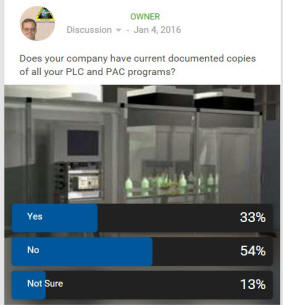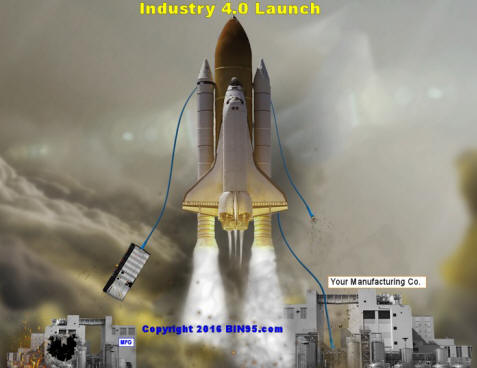Industry 4.0 in USA: Risk
- Home >
- articles >
- automation >
- industry 40 in usa
IE: IIoT - The Industrial Internet of things & Cyber-Physical Systems (CPS)
A major drawback to Industry 4.0 that few write about is the maintenance of an Industry 4.0 plant. The maintenance aspect is a much greater and immediate drawback than even the commonly known major concern of security, and the lesser concern of system integration standards. Maintenance of 4.0 systems has and will continue to result in related huge increases in process downtime. The barriers to overcoming the maintenance/downtime drawbacks of a 4.0 system are almost insurmountable.
Has the Smart Manufacturing Leadership Coalition (SMLC) addressed the maintenance paradox?
"... model also demands the ability to calculate and manage risk and uncertainty within very different operating structures. ..”
Industry 4.0 Maintenance barriers:
- On current less complicated PLC systems, only 1/3 of all manufacturers are maintaining current documented copies of all of their automation control (PLC/PAC) programs.
- The world Industry evolved to having maintenance personnel perform the job responsibilities of 2-6 additional skilled trades. (“Jack of all trades, master of none” is a barrier to operational excellence too.)
- 90% of all industrial maintenance personnel are not network certified, most are self-taught.
- Industry 4.0 will require an increase in maintenance training time and money budgets, yet training is the first budget cut.
- Most maintenance personnel report they lack the proper training on current less complicated automation systems. (REF: https://plc-training.org )
- Most maintenance personnel, who took a lifetime to acquire their current level of technological knowledge and skill, will be retiring.
- Social barriers common in manufacturing between maintenance, engineering, and IT departments should be considered too.
- Most manufacturers do not even have an asset manager employed. to manage all the machines, automation control, programs, software versions, firmware revisions, etc.
- Mistakes in it and computer programming only result in a reboot, reload, or loss of data. Mistakes in Industry 4.0 result in damage to man or machine. (The risk is much higher)
- Most current-day maintenance personnel have not been properly trained on PLC and automation management best practices. Even more, do not implement those best practices.
- Most company management is not aware of industrial network security and downtime risk their automation control personnel are currently placing the company at with the current limited networked equipment. (online changes, remote access, etc.)
- Plant IT personnel who will assist in automation equipment networking, also need to be properly trained on PLC and automation management best practices.
We all dream of the utopia of “smart factories able to self-diagnose, and then repair, in advance of causing production downtime." The reality is maintenance is already maxed out when it comes to capabilities, and always under-budgeted. Imagine adding to the many job titles one maintenance person already is responsible for, that they now also have to be an IT manager and computer programmer. In today’s current industry state, most cannot effectively implement a CMMS program and are just recently being convinced to hire a dedicated maintenance planner. (Industry has a reputation of being slow to change)

We are currently witnessing the industry going against their reputation of being slow to change, forced on them by the equipment manufacturers, and system integrators. With new asset purchases, instead of having a PLC in them designed to be user friendly to the maintenance electrician, the new equipment often has a PAC (industrial computer) in them designed to be user friendly to IT, computer programmer and the machine designer personnel, instead of the end-user… the maintenance electrician. Even this comparatively little change results in ten or more times the downtime and increases costs due to the maintenance barriers mentioned previously. Many scary situations have been witnessed in the rush to switch over to Ethernet, and computer control instead of industrial specific networking protocols. Like a maintenance engineer, or an IT person showing how they can control the plant on their smartphone via wifi. Some even let the world know their company is a soft target by posting conversations in online discussion groups, opening up not only a security risk, but also best practice violations, and risk to man or machine.
Don’t get me wrong, I personally would love to see industry 4.0 come to fruition. In 1995 I introduced TDC (True Downtime Cost methodology and associated books I authored), calling for industrial management decisions based on automated mass data collection, and analysis which really hasn’t been adapted yet, but Industry 4.0 will be the enabler. I just feel one should first master the current technology and especially the management of that technology, before taking on such a huge challenge. At least overcome the maintenance barriers mentioned above first. First, let maintenance get up to speed and comfortable working with the new industrial computers (PACs) controlling individual machines, and smaller systems before one links the entire plant together, making much of it interdependent.
The industry needs to take a step back and get their house in order before asking a maintenance person to fly a space shuttle. If you have the properly trained team in place and do not stretch them too thin, have redundancy, done the risk/reward analysis to include items mentioned in this article, then it is a mission go. It is not rocket science; the more complicated a system, the more properly trained personnel will need to be. Most likely, you will need new specialized positions to manage and maintain that complex system.
Disclaimer: Those who know me, hear this all the time … there are exceptions to every rule. Like in Germany where industry 4.0 was conceived. Where they are known for their precision technology development and employing personnel in each skilled trade, instead of combining several trades into one employee. There, successful Industry 4.0 implementation with minimum increases in downtime and risk may be more common. I am also sure a small percentage of companies throughout the world may be an exception to my observations and what others have reported to me. My opinions are referring to the industrialized world in general, and are based on my experiences primarily in the USA. Thus the title Industry 4.0 in the USA.
Get Industry 4.0 PDF version of this article.
Keep’n it Real: Industry 4.0 (the 4th wave of the industrial revolution) which consists of the Industrial Internet of Things (IIoT) and the like, is really part of a much bigger revolution, the 21st Century Information Technology Revolution. For clarity Industry 4.0 is a term Germany uses, other countries use other terms to define their similar programs. IIoT spawned from IoT is more defined as one of the many technologies to be utilized in such programs as Industry 4.0 and therefore Industry 4.0 in the USA initiative. A couple of examples of Industry 4.0 in the USA are 'Smart Factory' and 'Connected Enterprise'. This article's advice is for the implementation of either or both.
About the Author: Don Fitchett founded the activity-based costing system called "True Downtime Cost" (TDC), authored books and speaks at conventions on the topic, and is president of BIN. Don has been in the industrial training sector for over two decades, setting up training programs around the world, and still conducts PLC training seminars and onsite PLC training workshops to this day.
Copyright 2016 BIN95.com (You may link to this article only)

